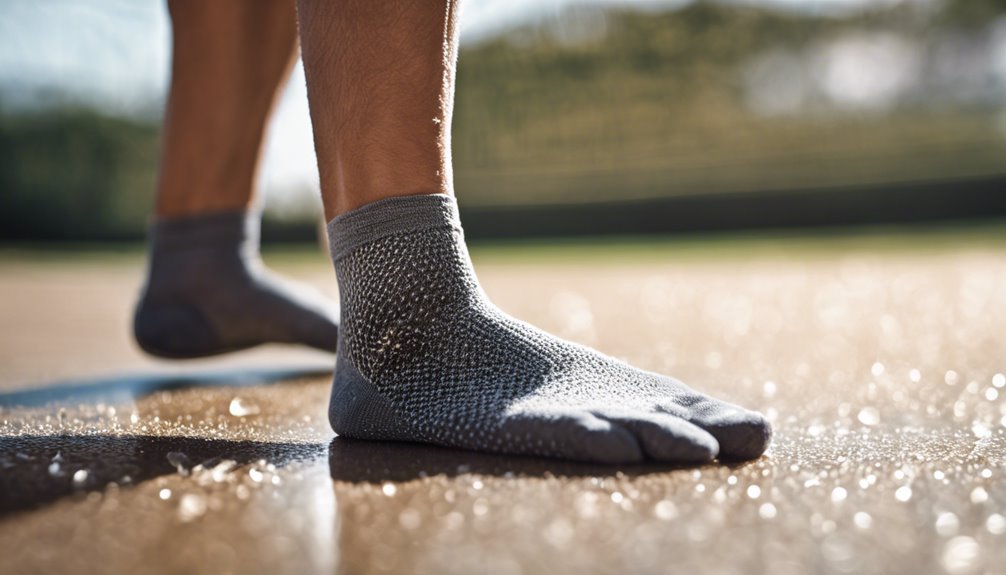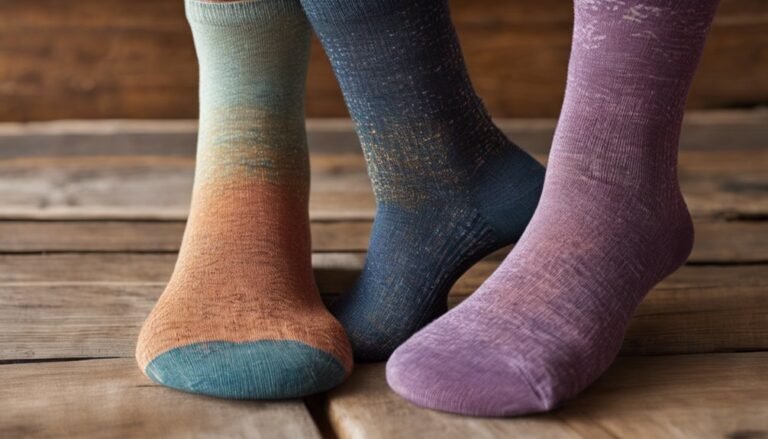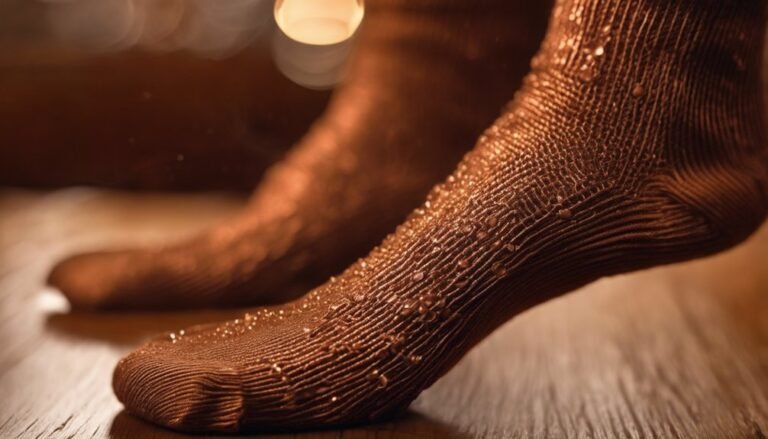Why Athletes Need Moisture-Wicking Socks to Prevent Blisters
Imagine this: you're in the middle of a crucial game, and suddenly, you feel a painful blister forming on your foot. The discomfort is distracting, your performance is affected, and you're left wondering if it could have been prevented.
This is why moisture-wicking socks are essential for athletes. These specialized socks prevent blisters by managing sweat, reducing friction, and enhancing comfort through technical materials like polyester, nylon, and Merino wool.
Blisters can alter your biomechanics, disrupt performance, and increase the risk of injury. A snug fit, seamless construction, and strategic cushioning enhance support, minimizing friction.
Quality socks equipped with moisture-wicking technology keep your feet dry, allowing you to maintain focus and achieve peak performance.
Discover more secrets to choosing the perfect gear.
Understanding Blisters and Their Impact on Performance

While often underestimated, blisters can considerably hinder an athlete's performance by causing discomfort and altering biomechanics. Understanding blister formation is vital for maintaining peak performance. Blisters typically form due to friction, heat, and moisture, creating fluid-filled pockets between skin layers. This not only leads to pain but can also cause performance disruption by forcing you to adjust your stride or posture subconsciously, which might lead to further injury.
To minimize blister risk, focus on reducing friction and moisture. Choose footwear that fits well and consider the use of specialized socks designed for athletes. These socks can help you maintain focus on your goals, rather than being distracted by pain. Remember, the freedom to move without hindrance is essential, and taking preventive measures is key.
The Science Behind Moisture-Wicking Technology
When it comes to enhancing athletic performance, understanding the science behind moisture-wicking technology is essential. At its core, moisture management revolves around transporting sweat away from your skin to keep you dry and comfortable. Fabric technology plays a significant role here, utilizing advanced fibers designed to pull moisture to the fabric's outer surface. This rapid evaporation process prevents sweat accumulation, reducing the risk of blisters, a common athlete's nemesis.
Think of it as a smart system: microfibers engineered for maximum breathability and capillary action. These fibers create a dynamic flow, moving moisture away efficiently. By wearing moisture-wicking socks, you gain the freedom to focus on your performance instead of discomfort. Embrace this technology, and you'll experience unparalleled comfort and blister prevention on every stride.
Materials That Make Moisture-Wicking Socks Effective

To truly appreciate the effectiveness of moisture-wicking socks, you must explore the specific materials that make them superior. The right fabric types and sock construction are essential to preventing blisters and ensuring comfort during intense activity. Look for materials that combine breathability and durability. Here's what you should focus on:
- Polyester: Known for its hydrophobic properties, it repels moisture away from the skin.
- Nylon: Adds strength and elasticity, vital for maintaining sock shape.
- Merino Wool: Naturally wicks moisture while providing temperature regulation.
- Acrylic: Lightweight and quick-drying, enhancing moisture management.
- Spandex: Offers stretchability, ensuring a snug fit without slipping.
How to Choose the Right Moisture-Wicking Socks
Selecting the right moisture-wicking socks involves understanding your specific athletic needs and the conditions in which you'll be performing. Start by considering sock features such as fabric blend, cushioning, and ventilation zones. These elements are essential for ensuring effective moisture management and blister prevention. Look for socks made from synthetic fibers like polyester or nylon, which excel at wicking away moisture.
Sock fit is equally important. A proper fit prevents friction and slippage, both common culprits of blisters. Choose a size that offers a snug fit without being too tight, ensuring ideal blood circulation. Additionally, pay attention to the sock's arch support and seamless construction, enhancing comfort and performance. Prioritize choosing high-quality options that align with your activity level and environment.
The Long-term Benefits of Investing in Quality Socks

While it may seem like a small detail, investing in quality moisture-wicking socks can yield significant long-term advantages for athletes. Premium socks enhance performance and comfort, protecting your feet over time. Here's why you should consider this investment:
- Sock Durability: High-quality materials guarantee your socks last through intense training sessions.
- Cost Effectiveness: Though initially pricier, these socks save money by reducing frequent replacements.
- Moisture Management: Advanced fabrics wick sweat away, keeping feet dry and blister-free.
- Enhanced Comfort: Cushioned soles and seamless construction provide unparalleled comfort.
- Injury Prevention: Proper fit and design minimize risks of common foot injuries.
Frequently Asked Questions
How Often Should Athletes Replace Their Moisture-Wicking Socks?
Imagine your socks as the foundation of freedom in motion. Replace them every six months to guarantee ideal sock lifespan and athlete comfort. This prevents wear that compromises their technical performance, letting you move without constraint.
Can Moisture-Wicking Socks Be Used in All Sports?
You can use moisture-wicking socks across all sports due to their advanced moisture management. Sock technology guarantees peak breathability and comfort, freeing you from discomfort. They're versatile, making them an essential part of your athletic gear.
Are There Any Specific Brands Recommended for Moisture-Wicking Socks?
Steering sock performance is like charting a course through a sea of options. Brands like Balega and Smartwool often rise above, offering superior moisture control and durability. Compare features and find your perfect fit for ultimate freedom.
Do Moisture-Wicking Socks Require Special Washing Instructions?
When caring for moisture-wicking socks, always check the label for specific washing techniques. Generally, use cold water and a gentle cycle to maintain fabric integrity. Avoid fabric softeners, as they can hinder performance by clogging fibers.
Can Moisture-Wicking Socks Help With Odor Control?
Yes, moisture-wicking socks can aid in odor prevention. The advanced fabric technology efficiently manages moisture, minimizing bacterial growth and associated odors. You'll enjoy fresh freedom with less worry about unpleasant smells during your athletic endeavors.






